The KEYLESS GO feature makes the KEYLESS START even more attractive
What is KEYLESS GO?
With KEYLESS START, you can step on the brake and press the START/STOP button on the dashboard to start the car—no key required. This feature comes standard across the Mercedes-Benz lineup.
KEYLESS GO is essentially an upgrade of KEYLESS START. You can still start the engine, but KEYLESS GO also has the ability to automatically lock or unlock the vehicle when the door handle is touched. This feature comes standard in models like the GLE Coupe and S-Class Coupe and available as on option on any new Mercedes-Benz.
Functionality
As with all systems controlled by the user, the KEYLESS GO system needs to be understood by the consumer to avoid misconceptions as to how it operates and complaints grounded in misinformation. Educating your customer sometimes solves many concerns.
With Mercedes-Benz KEYLESS GO, you can unlock and lock the vehicle, start and stop the engine, or even close the windows and sunroof from the outside of the vehicle, by simply having the SmartKey in the immediate vicinity of the vehicle, usually your customers pocket or purse.
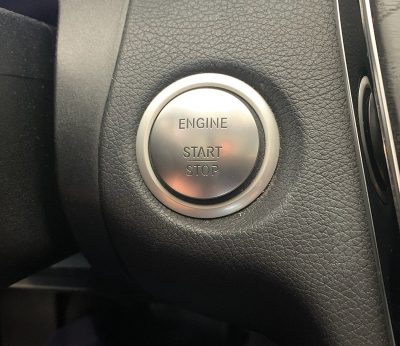
To unlock the car, firmly grip the driver door handle. To unlock all doors, grab any of the passenger handles. Most models have a removable push button located in the ignition and the dash that allows you to insert your Smart Key and start the vehicle in a conventional manner by inserting the key. This can come in handy if the key fob battery dies.
If the button is in place, each press is like turning the key one position as long as you don’t press on the brake. With one touch you can turn on the vehicle’s accessories such as the radio. Press the button a second time and the dash lights and all electrical items will turn on. Pressing a third time with your foot off the brake will turn everything off. You can also turn all features off by opening the door. To start the engine, simply step on the brake and push the START/STOP button. To turn the engine off, stop the car, leave your foot on the brake, shift to park and set the parking brake, then press the START/STOP button once again.
If you want to lock your vehicle from the outside, simply touch the sensor located on the door handle. If you’ve forgotten to close the windows and sunroof simply keep your finger on the sensor until the windows and sunroof finish closing. Many times you will solve some customer concerns with a simple demonstration of how the system operates.

Shutting Off the Engine
When the KEYLESS GO START/STOP button is pressed while the engine is running, the engine is requested to shut down. The electronic ignition lock control unit detects when the KEYLESS GO START/STOP button is pressed and transmits the status “START/STOP button pressed” to the KEYLESS GO control unit via the interior CAN. The KEYLESS GO control unit evaluates this and transmits the request “shut off engine” via the interior CAN, electronic ignition lock control unit and chassis Flex-Ray, drive train control unit and engine CAN to the CDI or ME-SFI control unit. The CDI or ME-SFI control unit then shuts off the engine depending on vehicle speed. If the vehicle speed is less than 3 km/h, the engine is switched off immediately. If the speed is greater than that the engine will only be switched off if the START/STOP button is pressed for more than 3 seconds.
Starting the engine pretty much follows the same sequence of events but the request is “start engine” and there are a few more functional requirements:
- The transmission must be in park or neutral – the fully integrated transmission control unit sends the transmission selector lever position to the electronic ignition lock control unit via the drive train CAN, the powertrain control unit and the chassis FlexRay.
- The service brake pedal must be actuated – the electronic stability program control unit reads in the status of the brake light switch (except hybrids where it looks at the pedal angle sensor signal) and transmits it to the EIS control unit via the suspension FlexRay.
- In manual transmission vehicles, the clutch pedal must be actuated.
The KG control unit evaluates all these signals and transmits wake up and location finding signals to the transmitter key via the center console KG antenna. The transmitter key transmits its drive authorization code and its position (determined by which antenna(s) it ‘hears’) to the KG control unit via the rear window antenna or the windshield antenna depending on the model, and the antenna amplifier. The KG control unit transmits this data to the EIS control unit via the interior CAN.
The EIS control unit checks the drive authorization code. If this is determined to be valid, the EIS control unit sends the status circuit 50 “on” via the chassis FlexRay, the drivetrain control unit and the engine CAN to the engine control unit.
Electronic Ignition Lock Control Unit (EIS)
This control unit has many of the same tasks as in pre-KG systems:
- Central gateway (interface between CAN and chassis FlexRay)
- Reading of signals
- Evaluation of input factors
- Output of signals
Central Gateway or Interface Between CAN and Chassis FlexRay
The processor for controlling the central gateway functions acts as the interface between these network buses:
- Interior CAN (CAN B)
- Diagnostic CAN (CAN D)
- User interface CAN (CAN HMI)
- Periphery CAN (CAN PER)
- Chassis Flex Ray
Thus all the input signals are read in through these connections. The input factors that have been read in are evaluated by the integrated microprocessor at which point the relevant signals are then issued.
Output Signals
The output signals are issued over the following connections
- Direct line
- CAN Buses
- Chassis FlexRay
Direct Line Signals
The following signals are read in via a direct connection:
- Terminal 30
- Circuit 30b (emergency battery supply)
- Status of KEYLESS GO START/STOP button
- Status of left front door rotary tumbler switch in left front door lock
- Electronic steering lock control unit
- KEYLESS GO wake up line

Sequence for Position Finding of the Transmitter Key
How does the vehicle find the key transmitter? To reliably and securely perform the locking/unlocking function as well as the engine START/STOP function, it is necessary to determine the position of the transmitter key and authorize the procedure. For example, if the key is inside the vehicle, the locking function is disabled, and if the key is outside the vehicle, the starting function is disabled. Take a look at the illustration of the KEYLESS GO antennas to see how the control unit detects the area inside or around the vehicle where the transmitter key is located.

The position is determined when a capacitive sensor in a door handle or the trunk lid/lift gate handle is actuated. The KEYLESS GO control unit directly reads the signals from the capacitive sensors in the door handles. The Rear SAM reads the status of the trunk lid/lift gate handle and sends this information to the KEYLESS GO control unit. The KEYLESS GO unit transmits coded requests to the transmitter key via the KEYLESS GO antennas. The transmitter key receives these signals and transmits codes indicating its location in area A,B C, or D. The transmitted location code is received through either the rear window antenna or the windshield antenna (depending on the model) and the antenna amplifier, which then subjects these to plausibility checks and transmits them to the electronic ignition lock (EIS) control unit via the interior CAN. If all is well at this point the EIS authorizes the transmitter key.
On a weird note, if by chance if the customer is hauling a material such as an unusual amount of metal, it may interfere with the antenna signal. Also beware if a customer owns another Mercedes-Benz model: They may be using the wrong key. If the plausibility check fails, the KEYLESS GO does not forward a message to the EIS.
No Start Issues
We mentioned in the title the MIL code P0513. This is simply the generic code for a drive authorization failure. You may be confronted with a Mercedes-Benz OEM code such as B2266: DAS data implausible or any other number of codes relating to a failure to recognize the key. In the KEYLESS GO system the Drive Authorization System (DAS) is still the program used for starting the vehicle. The KEYLESS GO system simply adds the comfort features as noted previously. Without XENTRY Diagnosis any diagnosis for faults will be difficult as Mercedes-Benz relies heavily on the step-by-step diagnosis tree for the particular model you are servicing. In fact, the workshop manual in procedure AD00.00-P-2000-04B specifically instructs the technician to connect the STAR Diagnosis platform and start XENTRY to perform diagnosis and repairs. There is no diagnosis tree in the workshop manual. You can however with a high quality factory-type scanner check all the data inputs and outputs needed to solve a DAS failure.
Lets take a look at the Drive Authorization System and get an understanding of what happens when the key transmitter won’t start the vehicle. Side note: Never forget to look at the basics when confronted with a vehicle that won’t start. Nothing is more frustrating than spending a lot of time chasing down complicated leads only to find out the battery is weak, cable connections compromised, or a new starter is needed!
The DAS ensures that the vehicle can only be unlocked and started with a valid access authorization code. The DAS checks this access authorization code. If this is valid, all the control units involved in the DAS compare the access authorization code with each other and the DAS issues a start enable only after a successful comparison.
Function requirements when the transmitter key is used are:
- Transmitter key in the vehicle interior
- Transmitter key authorized
It should be noted also that some models have the option to use a qualifying mobile phone or digital vehicle key sticker (Digital Vehicle Key). These must be:
- Stored in the stowage compartment in the center console
- Digital vehicle key is authorized
The access authorization code is queried by all involved control units. Check, release and feedback is performed separately by each control unit.
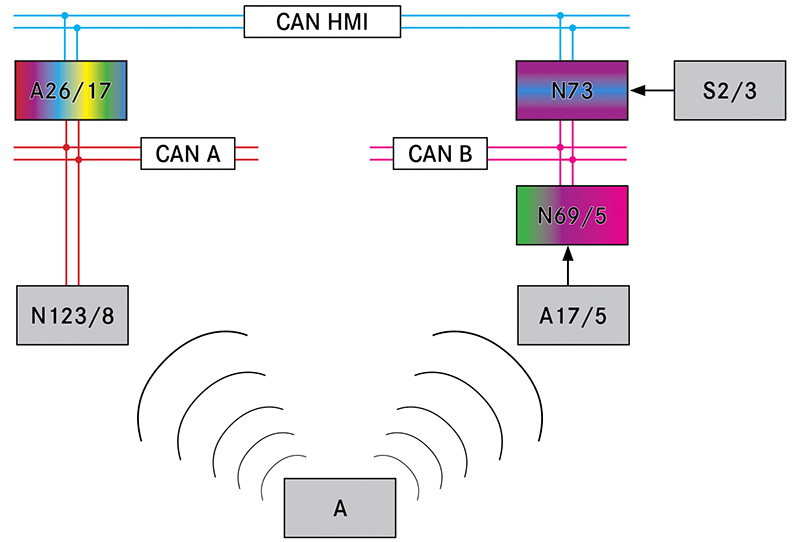
Checking for Proper DAS Authorization

Connect a factory type scan tool and run a quick test to look for DAS codes. Monitor the actual values in the Electronic Ignition Switch under the term DAS Drive Authorization System. You will then want to verify that the start enable states “Yes.” Now, verify immobilizer states “Not Activated,” and also check and see that circuit 50 is shown to operate when the key is in the crank position. If the checks show “No,” “Activated” or “Off,” you should check the data for valid key detected. If “Valid Key Detected” states “No,” you may have a problem with your key transmitter. Always try and get a second key transmitter from the customer if possible when dealing with possible DAS issues. If no problems are found with the actual key or authorization, then you need to look elsewhere, possibly test for operation of the start relay and the starter solenoid fuse.
If Drive Authorization is found to say start enable “No,” further scan tool testing will be needed to determine if communication issues are at fault.
Function Sequences for the Interrogation of the Transmitter Key
The KG control unit starts the check for an authorized transmitter key under the following conditions:
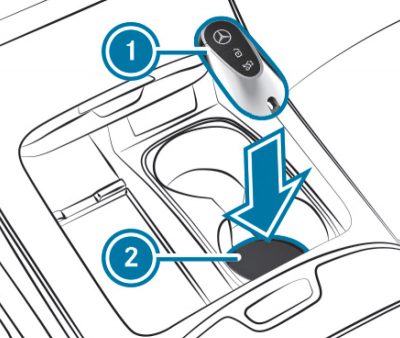
- When the final door is closed
- If starting off at a speed greater than 0 mph and a door or trunk/lift gate are not closed.
If the vehicle happens to stop and a door is opened, no new interrogation takes place. If, when attempting to start the engine, no valid transmitter key is recognized in the vehicle interior after checking, the instrument cluster outputs the message “Key not recognized” in white lettering. If a transmitter key is not recognized in the vehicle interior after starting off (i.e. a customer drops her husband at the store and he has the key in his pocket), the message “key not recognized” appears in red lettering. It is possible to switch off the engine at this point but it will not restart. The message will remain on the cluster until the door status has changed or circuit 15 is off.
What About the Key Fob Battery?
If the battery of the transmitter key is discharged or the wireless connection is malfunctioning, the vehicle can still be started via the emergency start function. In most models, you pull out the START/STOP button and insert the key, which is the procedure since the SmartKey was introduced. In many newer models, the START/STOP button is not removable. In these models, the transmitter key must be placed in the emergency start key cradle in the center console for this purpose. Check the owner’s manual for the exact location for a specific vehicle.
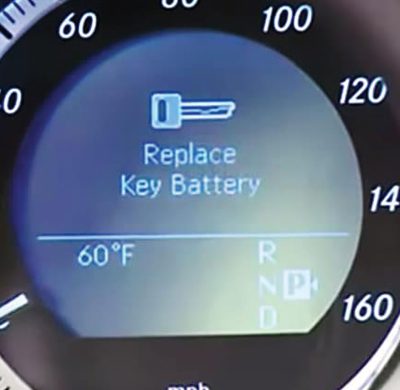
Via a transponder interface, the corresponding data is then exchanged for the identification of the transmitter key. After a brief moment, the drive authorization system then issues the start enable. Many shops have had reports from their customers that the key fob battery low warning pops up but they have recently replaced the battery. In many cases, it turns out they went to one of those “Batteries R Us” type places and had a cheap or shelf worn battery installed. Your Mercedes-Benz parts department will always have a fresh set of batteries in stock to solve many of these types of issues.
Most parts related to the Drive Authorization System fall under the category of Theft Relevant Parts (TRP) and will require proper documentation. A new key transmitter certainly falls under this category. Note that in 2020, Mercedes-Benz USA changed the policy concerning vehicle keys: A NASTF-Registered Vehicle Security professional can now purchase keys over-the-counter for their customers. Having a good relationship with your local Mercedes-Benz parts department will assure you of repairing the vehicle properly with the right parts every time.



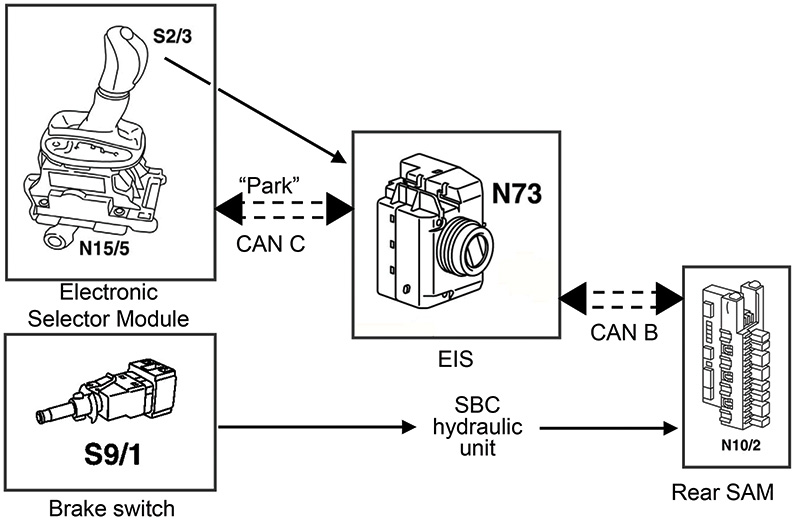




0 Comments